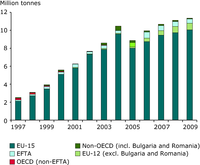
The figure illustrates the amount of transboundary shipped notified waste, in Million tonnes, traded from EU-member states to different countries. These cover countries within EU-15, EFTA, Non-OECD (inkl. BG and RO), EU-12 excl. BG + RO and OECD (non-EFTA).

Generation and recycling of packaging waste in the member countries of the European Environment Agency. The data show that 17 countries in 2009 met the 2009 target of the Packaging Waste Directive (2004/12/EC) to recycle at least 55% of packaging waste generated, and two countries missed the 2001 target to recycle at least 25%.

The figure is a bar plot of the generation of municipal waste in kg per capita, covering 2003 and 2010.

The total generation of waste in the EU-27, Croatia, FYR Of Macedonia, Norway and Turkey divided into 7 different categories. The figure shows that nearly two thirds of all waste in 2008 was mineral waste, mainly from mining, quarrying, construction and demolition.

Change 2000 to 2009 in EU-15/EU-12: Total DMC (– 9.9/+ 28.4 %);
Biomass (– 2.4/+ 5.8 %); Metals (– 35.9/– 22 %);
Non-metal minerals (– 13.5/+ 82.4 %); Fossil fuels (– 5.6/– 5.1%).
EU-15 includes Austria, Belgium, Denmark, Finland, France, Germany, Greece, Ireland, Italy, Luxembourg, the Netherlands, Portugal, Spain, Sweden and the United Kingdom.
EU-12 includes Bulgaria, Cyprus, the Czech Republic, Estonia, Hungary, Latvia, Lithuania, Malta, Poland, Romania, Slovakia and Slovenia.

The ecological footprint is a measure of the area needed to support a population's lifestyle. This includes the consumption of food, fuel, wood, and fibres. Pollution, such as carbon dioxide emissions, is also counted as part of the footprint. Biocapacity measures how biologically productive land is. It is measured in 'global hectares': a hectare with the world average biocapacity. Biologically productive land includes cropland, pasture, forests and fisheries

-

-

-

Consumption here refers to human consumption only. No consumption data are available for Liechtenstein.

-

-

The figure shows the trends in EU greenhouse gas emissions compared to 1990/base year

Specific number of bathing waters per million inhabitants, per coastline and per land area

-

-

The upper graph and left axis show annual anomalies and the lower graph and the right axis show decadal average anomalies for the same datasets. The figure compares three analyses of observations.
The black line refers to data from HadCRUT3 from the UK Met Office Hadley Centre and University of East Anglia Climate Research Unit, baseline period 1850–1899 (Brohan et al., 2006).
The green line refers to data from GHCN-M version 3.1.0 from the US National Oceanic and Atmospheric Administration (NOAA) National Climatic Data Centre, baseline period 1880–1899 (Smith et al., 2008).
The blue line refers to data from GISSTemp from the National Aeronautics and Space Administration (NASA) Goddard Institute for Space Studies, baseline period 1880–1899

-

The map shows the population’s perception of the quality of public and civil services and their degree of independence from political pressures, the quality of policy formulation and implementation, and the credibility of the government’s commitment to such policies.

The map shows an index on demographic dependency for European cites